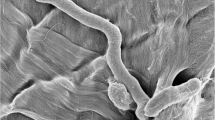Abstract
Nine strains ofHelicobacter pylori have been isolated exhibiting spontaneous mutations with a loss of catalase activity. Growth characteristics in vitro were unaffected by the mutation showing that catalase is not essential for growth ofHelicobacter pylori. Parent strains and mutants could not be distinguished morphologically from each other when compared by electron microscopy. Restriction endonuclease digestion withHindIII, separated in an 0.7 % agarose gel in TBE buffer, showed each pair to be highly related to each other. SDS-PAGE separation of proteins from four mutants and parent strains showed that all mutants lacked a 57 kDa protein. The partial N-terminal sequence of this protein shows homology with maize catalase and may be the subunit of theHelicobacter pylori catalase tetramer. It is concluded that catalase negative mutants ofHelicobacter pylori occur spontaneously in vitro, but have not yet been observed in vivo. The paucity of such catalase negative strains in clinical specimens could mean that catalase is a virulence factor in vivo that puts mutants at a selective disadvantage.
Similar content being viewed by others
References
Goodwin CS, Blincow ED, Warren JR, Waters TE, Sanderson CR, Easton L: Evaluation of cultural techniques for isolatingCampylobacter pyloridis from endoscopic biopsies of gastric mucosa. Journal of Clinical Pathology 1985, 38: 1127–1131.
Eaton KA, Brooks CL, Morgan DR, Krakowka S: Essential role of urease in pathogenesis of gastritis induced byHelicobacter pylori in gnotobiotic piglets. Infection and Immunity 1991, 59: 2470–2475.
Goodwin CS, Armstrong JA, Peters M: Microbiology ofC. pylori. In: Blaser MJ (ed):Campylobacter pylori in gastritis and peptic ulcer disease. Igaku-Shoin, New York, 1989, p. 25–49.
Hazell SL, Evans DJ, Evans DG, Graham DY:Campylobacter pylori catalase: a putative virulence factor. In: Ruiz-Palacios GM, Calva E, Ruiz-Palacios BR (ed): Campylobacter V. Proceedings of the 5th International Workshop on Campylobacter Infections. Instituto Nacional de la Nutricion, Mexico City, 1991, p. 367–368.
Hazell SL, Evans DJ, Graham DY:Helicobacter pylori catalase. Journal of General Microbiology 1991, 137: 57–61.
Langenberg W, Rauws EAJ, Widjojokusumo A, Tytgat GNJ, Zanen HC: Identification ofCampylobacter pyloridis isolates by restriction endonuclease DNA analysis. Journal of Clinical Microbiology 1986, 24: 414–417.
Laemmli UK: Cleavage of structural proteins during the assembly of the head of bacteriophage T4. Nature 1970, 227: 680–685.
Matsudaira P: Sequence from picomole quantities of proteins electroblotted onto polyvinylidene difluoride membranes. Journal of Biological Chemistry 1987, 262: 10035–10038.
Westblom TU, Madan E, Midkiff BR: Egg yolk emulsion agar, a new medium for the cultivation ofHelicobacter pylori. Journal of Clinical Microbiology 1991, 29: 819–821.
Queiroz DMM, Mendes EN, Rocha GA: Indicator medium for isolation ofCampylobacter pylori. Journal of Clinical Microbiology 1987, 25: 2378–2379.
Switala J, Triggs-Raine BL, Loewen PC: Homology among bacterial catalase genes. Canadian Journal of Microbiology 1990, 36: 728–731.
Abril N, Pueyo C: Mutagenesis inEscherichia coli lacking catalase. Environmental and Molecular Mutagenesis 1990, 15: 184–189.
Vercellone PA, Smibert RM, Krieg NR: Catalase activity inCampylobacter jejuni: comparison of a wildtype strain with an aerotolerant variant. Canadian Journal of Microbiology 1990, 36: 449–451.
Hazell SL, Graham DY: Unsaturated fatty acids and viability ofHelicobacter (Campylobacter) pylori. Journal of Clinical Microbiology 1990, 28: 1060–1061.
Christie WW, Moore JH: The structure of egg yolk triglycerides. Biochimica et Biophysica Acta 1970, 218: 83–88.
Author information
Authors and Affiliations
Rights and permissions
About this article
Cite this article
Westblom, T.U., Phadnis, S., Langenberg, W. et al. Catalase negative mutants ofHelicobacter pylori . Eur. J. Clin. Microbiol. Infect. Dis. 11, 522–526 (1992). https://doi.org/10.1007/BF01960807
Issue Date:
DOI: https://doi.org/10.1007/BF01960807




